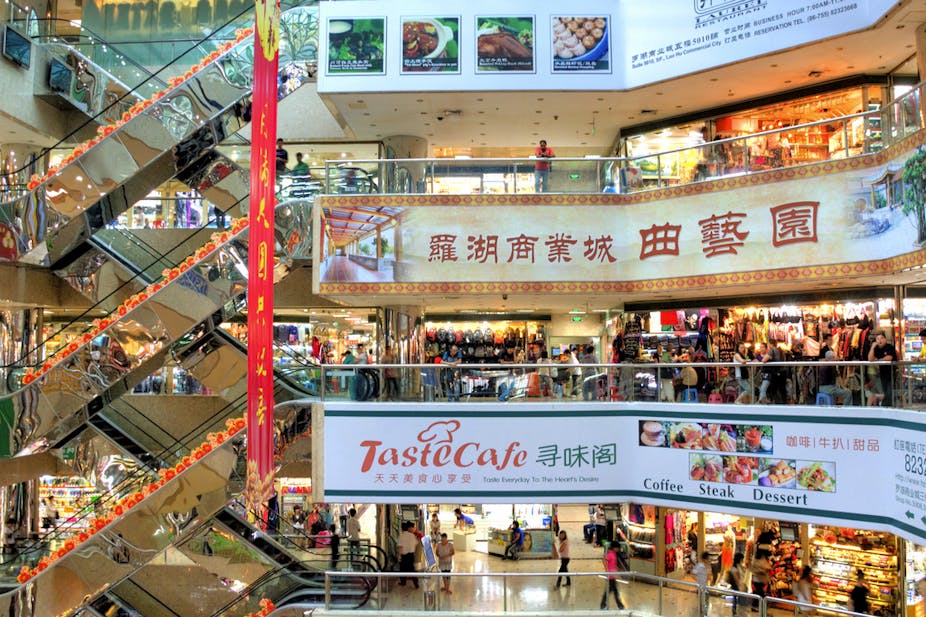Why are retail sales in the doldrums, or headed online? To me, it’s in part because Australian shopping malls are bland, uninteresting containers of branded chain stores and the same old franchises offering shoppers a very limited choice of products, wherever they may go. There is no point crossing town to visit another mall when it’s the same as the one around the corner. No wonder the panoply of delights online is proving so tempting.
Why are our malls and stores so boring? Perhaps land use planning is part of the problem. The contrast between our retail environments and those of cities elsewhere is immediately apparent to anyone who travels broadly.
Planning, malls and monopolies
As noted by the Productivity Commission, retail planners in Australian state and local governments promote a hierarchy of “activity centres”. Their plans try to reinforce a dominant central business district (CBD), which is ringed by large suburban shopping malls, which in turn are ringed by smaller neighbourhood centres and supermarkets in surrounding suburbs. These plans accord with what is seen as the most efficient spatial arrangement if the market is left to its own devices.
The theories underpinning these plans derive from the work of German analyst Walter Christaller, who identified such hierarchical patterns in activity centres across southern Germany in the 1930s. Planners try to approve enough retail space to create competitive, vital retail environments.
Within this hierarchy, planners designate “key centres”, most of which are the largest suburban malls in the middle-ring and outer suburbs, owned and managed by the large mall operators. Clustering is encouraged to make it easier to provide infrastructure, including public transport. Out-of-centre developments are strongly discouraged, which is why, at the smaller scale of neighbourhood centres, Aldi has found it so hard to break in to the Coles/Woolworths duopoly.
The regulations hand a monopoly to existing mall owners. Existing malls can fight off new entrants in court to stop them coming near their patch. The run of mall expansions over the years have made these centres larger and larger, and the monopolies more entrenched.
For shopkeepers, the malls have the upper hand when it comes to negotiating leases. Rents are high and the stipulated conditions are tough. The malls have the only good store locations in key parts of the city and it’s difficult to prosper elsewhere. Small businesses find it too difficult to get in, ensuring the chain stores you find in malls are essentially the same all over the country. There is a startling lack of variety in such categories as men’s fashion. The possibilities of edgy new Australian brands emerging (the next Sass & Bide) are slim.
Regulating malls for competition and differentiation
By contrast, many Asian cities now plan activity centres for diversity, not for monopoly. At suburban Wu Jiao Chang in Shanghai, for example, there are four or five smaller shopping malls clustered together, stand-alone department stores, plus supporting restaurant strips and a “food mall” (which is very different!). Though the urban design is poor at times, the variety offered is no accident.
Each individual mall owner has a relatively low maximum floorspace they are allowed to own and operate. If other mall operators want to come in, they are encouraged - not discouraged - by the rules. The land designated within the activity centre area allows room for new malls to be built. But you can’t construct a mall elsewhere nearby, it must be in the centre, which is supported by two metro stations. As such, the adjacent malls compete fiercely with each other for tenants and in being as attractive as possible to customers.
There is a little over-capacity at Wu Jiao Chang, with cheaper rents in the upper floors. Small businesses are able to negotiate leases. All the main international and Chinese chain-stores are represented - and they dominate sales - but you find many stores with new designers and local start-ups. It makes for an interesting, varied shopping destination. Shopping is fun, in ways Australians only experience when abroad.
Alas, such proactive regulation was not even looked at by the Productivity Commission, which appears quite an oversight.
So don’t cheer if you hear that your local mall is expanding yet again. Think how much better it might be if a new mall opened next door instead.
It’s all a matter of better (and not more) regulation. If we get the settings right, we’ll get cheaper prices, more variety for customers and bring people back to the shops.

